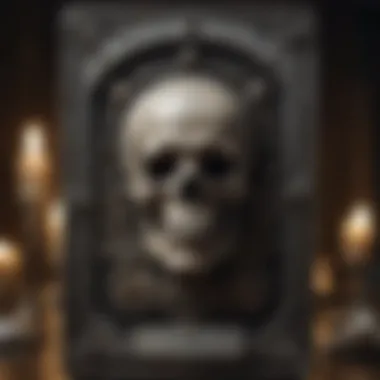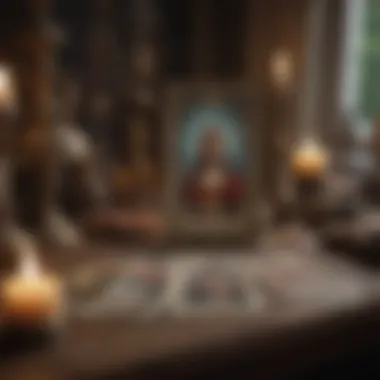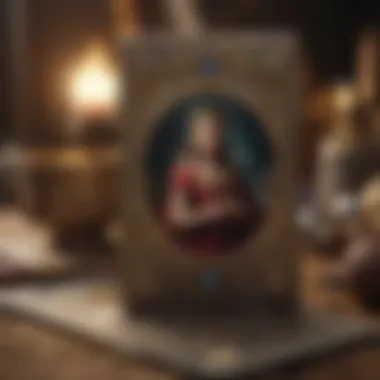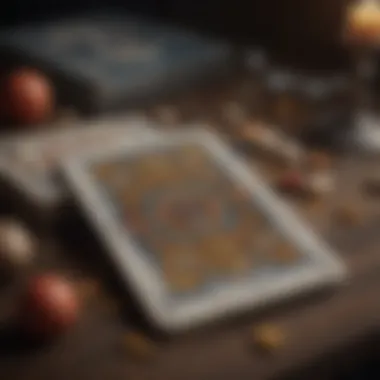Tarot and Mortality: Unveiling Life's Final Insights


Intro
The relationship between tarot and mortality presents a rich tapestry of insights into the human condition. For practitioners, understanding this connection involves not just the mechanics of tarot but the psychology and ethics behind divine explorations of life and death. Through examining the symbolism embedded in tarot cards, one can navigate feelings and thoughts associated with mortality. Various tarot symbols frolic in the interface of life transitions, reflection and the mysteries death invites.
The significance of mortality is consistently lurking in human consciousness. Therefore, a framework of tarot readings closely tied to mortality unveils truths that transcend mere existential concerns. This narrative guides readers through the concepts functionally extracted from tarot and intertwines them with queries surrounding existence. As we embark on this examination, the interplay between learning and sharing insights becomes paramount. Rather than reducing mortal issues to trivial reflections, this discussion must uphold incalculable weight — as we dive into the ways tarot auspiciously aids seekers in grappling with their mortality while reflecting broader philosophical queries about existence itself.
Understanding Tarot's Symbolism Related to Mortality
To empathize deeper with mortality interpretations in tarot, we examine essential symbols present in the tarot deck. Each signification resonates within diverse readers and reflects how they confront their life values.
Symbols Pertaining to Death and Transformation
Several cards notably resonate with themes of death while inspiring transformation. The Death card, for example, famously contradicts common perceptions. Instead of indicating the literal end, this iconic card embodies transition and renewal, representing transformative events in life.
The Tower card, characterized by catastrophic change or upheaval, also shares aspects of mortality. Often, significant loss or drastic events precede personal growth and transformation. Consequence precedes clarity, offering the law of renewal through trial.
The Fool's Journey and Life Cycles
In tarot reading, the trajectory illustrated by the Fool’s Journey links closely with delighting in mortal destinies. Each card carries implications wherein life's stages manifest through experiences. The exploration of through lessons tethers seekers to life's temporality yet reveals paths toward ongoing metamorphosis: - Saying goodbye to accepted norms - Accepting contradictions - Moving toward partnerships to synthesize lived nuances.
The Ethos Behind Mortality-related Tarot Readings
Addressing mortality raises ethical inquiries when engaging tarot seekers. Each interpretation holds weight, and responder responsibilities bear influences on invaluable stages.
Psychological Nuance with mortality questions
Seeking answers about death, individuals occasionally endure overwhelming uncertainty. Intentionally sensitive approaches to these subjects are necessary.
Considerations for tarologists exist in the framework while conducting reading:
- Recognizing seekers' emotional states and environment
- Addressing broader choices without employing inflexible closures
- Considering gestation periods of grief as a range and path toward acceptance.
“Every pursuit of development arcs uses delicate tending at moments, especially of matters tied with mortality.”
Tarot can effectively serve as a gentle guide. Yet, tarologists must remember their authoritative discretion with caution while sharing knowledge about domain complexities.
In its entirety, mortals may perceive tarot metaphorically as a lens projecting their narratives of self—and yet, seekers remain positioned along a broader trajectory of illumination, employing the fractals, degrees, and depth of existence presented at diverse junctures of tarot's experience.
Ending
Tarot and concepts of mortality work synergistically as people reach for understanding life’s nuances. Ethically-encompassed engagement proves an insightful seed through interpretations, aiding not just death queries — entwining rich perspectives on both life and individual worldviews offered from both existential outlooks. In this shared illumination, mortality blossoms onto lived wisdom, representing a journey unique and distinctive for every seeker encountering the vast territories of tarot interpretation. Through these exploration steps, both resiliency and introspection remain discovered in how intimately typecast realities impact behavior toward understanding human finitudes.
Understanding Mortality within Tarot
Understanding mortality is a significant aspect when exploring tarot within its broader context. The interplay between life and death resonates deeply in human consciousness. Tarot offers a unique lens through which to consider mortality's complexities. This section aims to identify critical elements and benefits associated with this exploration.
The relevance of addressing mortality through tarot is paramount. Practitioners often encounter clients grappling with existential questions, therapeutic needs, or heightened realization of life’s impermanence. Understanding the theme of mortality provides a framework for addressing fears related to loss and the unknown. Such reflections help shape one’s perspective on life's transient nature, fostering a richer engagement with the tarot practice.
Moreover, tarot provides symbols and narratives that express the intricate realities of mortality. From interpretations of the Death Card to broader reappearances in various spreads, each element conveys layers of personal meaning. This nuanced approach empowers seekers to discover insights into their journeys while confronting profound topics that could otherwise appear burdensome.
The Concept of Mortality in Tarot


The Council of Elders Tarot generally communicates the cyclical nature of life and death. Relying on genuine symbols that correlate to mortality, the tarot maintains faith in positive transformative experiences, rather than fixed notions of despair. The narrative stance shifts from fear of the end towards embracing cycles of existence. Some card sets may illustrate that the endings often elicit new beginnings, enhancing clarity concerning life’s natural flow.
Various tarot interpretations indicate that confronting mortality aligns with self-awareness, insightful living, and acceptance. Many practitioners argue that genuine transformation sprouted from grappling with the true essence of mortality. The imagery associated with permanent endings offers profound contemplative spaces for users of tarot, allowing them to process serious questions about legacy and impact.
Symbols Associated with Death in Tarot
Tarot decks often feature several symbols that convey themes surrounding death and transition. The most prominent is typically the Death card, often misinterpreted as a glaring symbol of fear or violence. In contrast, cards such as the Ten of Swords starkly illustrate finality but, again, suggest closure, release, or rebirth.
Skulls and skeletons frequently appear as visual symbols throughout tarot art. These reveal connections to mortality; they serve as reminders of life’s fleeting nature. Other potent symbols include:
- Hourglass: Represents the passage of time and the inevitability of death.
- Phoenix: Symbolizes rebirth and renewal, often viewed alongside mortality.
- White flowers: Indipping the purity of life’s transience.
The symbols express the many facets of mortality intertwining themes of grief, transformation, and acceptance. Recognizing and interpreting these symbols deepens one’s understanding and provides clarity about one’s journey concerning mortality themes.
The Death Card: Interpretation and Implications
The Death card occupies a central place in the tarot landscape. Unlike many might think, this card symbolizes profound transformation rather than a mere end. It is essential to address the interpretation and implications of this card. Understanding the Death card is crucial for grasping the broader context of mortality within tarot readings.
Understanding the Death Card
The Death card is numbered 13 in the Major Arcana and typically portrays a skeleton, often riding a horse. This imagery can evoke fear. However, at its core, the card suggests a significant change or transition. It represents the cyclical nature of life, urging one to let go of the old to make way for the new. Thus, this card isn't only about physical death; it's about transformations in various life aspects.
When this card appears in a reading, it usually signifies that something must be released. This could be a relationship, job, or belief. Embracing this change can lead to rejuvenation and renewal.
Methods for Asking Tarot about Mortality
Understanding how to effectively ask tarot about mortality is crucial for attaining clear insights and finding peace with existential questions. This section emphasizes the value in crafting thoughtful inquiries aimed at navigating the complex themes of life and death. A well-formulated question can lead to more profound and meaningful interpretations, shedding light on personal fears, acceptance, or clarification regarding mortality.
Formulating Questions about Mortality
When engaging tarot in the contemplation of mortality, the quality of the questions posed plays a significant role in the outcome of the reading. Ideal questions are specific, open-ended, and imbued with personal relevance. Questions could include:
- What lessons on mortality can I learn at this time?
- How can I better accept the concept of death in my life?
- What insights does the Tarot offer on my current perceptions of life and death?
It is important to hone in on internal motivations or fears. Consider explaining the context surrounding these thoughts. Providing elaborate background can deepen the reading’s potency. Being mindful about the emotional undertones is critical; a clear intention for seeking answers reflects respect for both the Tarot and your own process of discovery.
Recommended Tarot Spreads for Mortality Queries
Choosing the appropriate tarot spread is equally essential when exploring mortality queries. Spreads define the structure of the reading. Some notable spreads can include:
- Three-Card Spread: Present the past, present, and future regarding looks at emotional perceptions of death. It offers a concise snapshot.
- Celtic Cross: Focuses on significant life aspects, a robust approach gives an in-depth analysis on one's feelings toward mortality.
- The Death Spread: Specifically tailored for queries on death; examining loss, transformation, and renewal. It provides clarity on transitory experiences existing between realms.
Implementing these tailored spreads can help gain different perspectives on mortality-related queries. By aligning questions with the fitting setup, readings are more productive and insightful. Inquire carefully and always consider the personal interpretations that may arise within each card drawn. This space for self-reflection through tarot serves as an approachable method to grapple with existential thoughts.
Effective tarot readings on mortality not only explore fear but also highlight transformative potential, fostering growth in the face of life’s inevitable endings.
Perspectives from Practitioners on Mortality Readings
The importance of understanding perspectives from practitioners on mortality readings cannot be overstated. Tarot users often engage with questions of mortality that arise as deeply personal and sensitive topics. Insights gleaned from experienced readers provide a unique lens through which these interactions are understood. Experienced tarotists bring not only their understanding of the cards but also their empathy and intuition, greatly affecting the readings and the effectiveness of guidance offered.
Eliciting another layer of significance, knowledge from practitioners also bridges the gap between technical tarot meaning and lived experience. It helps to offer seekers clarity while navigating uncertain paths related to death or loss. Taking practitioners' sense of morality into account can foster a more holistic understanding of the tarot's role in exploring mortality.


- Understanding the reader's experience can clarify how different interpretations emerge.
- Recognizing emotional responses during readings allows readers to adapt to the unique needs of their clients.
- Practitioners can evaluate how past readings influenced other seekers' perception of mortality.
Through these insights, practitioners ultimately reshape stories and illuminate paths toward emotional restorativeness for others in crisis.
Insights from Experienced Tarot Readers
Experienced tarot readers often share that confronting mortality is a core aspect of their work. Many of them emphasize that morally responsible tarot readings must balance informative content with emotional sensitivity. They assert that the Tarot can be both a guide and a comfort when speaking about life and death.
The nuanced understanding captains reported allow them to develop their proficiency in handling queries about mortality. They identify key behaviors that influence how seekers perceive their experience.
- Many readings incite a significant response in viewers,
- Tarot can be a medium for closure,
- Altering intentionally the language used to soften the effect during uncomfortable discussions about death.
Documented Experiences with Mortality Readings
Documentation brings further legitimacy to the practice and reveals common themes in tarot regarding mortality readings. Many practitioners report instances where their work transformed the understanding of death for their clients. Anecdotes shared frequently highlight the variety that seekers display when seeking answers about mortality-related curiosities.
A variety of experiences emerge when practitioners document their unutual work:
- Seeker scenarios where closure emerged, confronting loss with support from tarot,
- Instances detailing clients accepting the future, can find calming guidance through the card's message,
- Anecdotes may feature breakthroughs, that help reflected thoughts rise above fears.
"Tarot does not resist the notion of mortality; instead, it helps us redefine it," states a seasoned tarot reader.
Through analytical considerations connecting personal accounts with a wider understanding of mortality, these documented readings offer valuable insight into the potential of tarot in facing the shadowy realm of death.
Psychological Impact of Seeking Death Readings
Understanding the psychological impact for seekers in mortality readings is crucial. Tarot can act as a reflective tool for individuals confronting significant life transitions, particularly those related to death. It provides them a narrative framework to explore deep fears and anxieties about mortality. This exploration acts as a form of guidance during challenging times. For many, engaging with tarot illuminates the unknowns associated with death and can be transformative.
Emotional Responses to Mortality Readings
When individuals seek tarot readings related to death, they often bring with them a complex array of emotions. Anticipation, anxiety, fear, and hope may coexist in this intimate space. Most seekers may feel a mix of uncertainty and curiosity about the afterlife. This dance of emotions can hinder a clear interpretation of the cards at times.
One of the main emotional responses is fear, which often surfaces when contemplating mortality. Death itself is shrouded in societal taboos, leading to profound angst. Yet among all these feelings, many individuals also experience relief during the reading process. They realize the inherent nature of change and its fluidity. Tarot readings uncover the possibility of understanding death not just as an end but as a beginning of another phase.
Studies shown in general psychology show that cognitive and emotional processing over mortality helps individuals forge links to death in a more constructive way. İn tarot, cards surrounding the Death card traditionally encourage an understanding of renewal and transformation. As such, a practitioner’s skill in navigating these emotions is vital for a helpful outcome.
“Engaging with the unapproachable often reveals truth shrouded in fear.”
Coping Mechanisms Involved in Seeking Answers
Coping is a critical component for those seeking insights into mortality. The unique nature of tarot allows seekers to confront their fears rather than evade them. Among common behaviors seen in people who engage in tarot for mortality questions, we find:
- Reflection and Journaling: After a reading, many choose to write about their insights. This practice cements thoughts and feelings, allowing for a deeper understanding over time.
- Discussion with Peers: Talking about experiences with other seekers or friends enhances journey processing. It supports shared emotions and helps normalize the experience.
- Mindfulness Practices: Some individuals engage in meditation or grounding exercises before or after tarot sessions. This calms the mind and opens pathways to digest complex material.
In a broader view, these coping mechanisms reflect the desire to dismantle larger fears surrounding death. They challenge prevailing narratives of despair in mortality while promoting acceptance and growth instead.
Ethical Considerations in Mortality Tarot Readings
Discussing mortality in tarot readings is a delicate matter. Readers navigate through intense emotional landscapes. Understanding ethical considerations is both vital for the reader's integrity and the guidance for their clients. It shapes how tarot serves as a tool for reflecting on life and death. The impact of words can linger long after a reading. Thus, ensuring a thoughtful, responsible approach matters critically.This attentiveness helps facilitate a better understanding between seeker and tarot reader. Responsible interpretations can shine light on situations, instilling hope rather than despair.
Responsibility of the Tarot Reader


The tarot reader holds significant responsibility during mortality readings. They must approach the topic honestly but sensitively. Establishing a bond of trust with the client is paramount. This trust allows clients to feel secure in discussing profound issues. The reader should acknowledge their own limitations in predictive certainty. They are not here to foretell death but to provide insight into its meanings. Clarity in communication supports clients. This enables the exploration of questions they may find vital.
Key responsibilities include:
- Honesty: Being truthful about attunements and possible outcomes without exaggerations or embellishments.
- Support: Maintaining a compassionate tone, validating the emotions of the client near end-of-life topics.
- Guidance: Tailoring interpretations to guide clients toward healthier mindsets about mortality.
Intuitive readings about death require careful cultivation of empathy and respect.
Successful tarot readings around mortality can create space for a positive dialogue about inevitable losses.
Navigating Sensitive Topics with Clients
Sense must prevail when navigating mortality issues. It's common that reactions to death discussions can be charged with fear and sorrow. Initiating conversation with sensitivity matters greatly. This approach aids in eradicating anxiety from the client’s experience. The reader can create a safe environment through simple practices:
- Warmth: Offering welcome and understanding upon greeting the client.
- Active Listening: Encouraging the client to share their feelimgs and thoughts, valuing their voice.
- Flexibility: Adapting the reading based on client comfort levels and adjustment underlines respect.
Readers should frame questions thoughtfully. Respected experiences dictate that asking open-ended queries can ease tension. Rather than posinitng a direct question about fear of death, a reader might ask general inquiries about life experiences that clients find thought-provoking.
Initiating a reflective dialogue helps clients unpack their concerns. Maintaining space for emotional release is key during these discussions. With tact, practitioners foster rich communication which could lead clients to user deeper understandings of their own mortality. Filtering each comment with care can yield a powerful portrait of insight that lasts well beyond the reading itself.
Alternative Methods to Explore Mortality
Alternative methods of exploring mortality through different practices enhance our understanding of life's profound questions. These methods can serve as complementary tools alongside tarot. Each offers unique perspectives about death and dying, enriching the journey of exploration.
Other Divination Tools for Mortality Questions
Diverse divination tools exist beyond tarot that can also illuminate the complexities of mortality. These include:
- Runes: This ancient Nordic practice involves symbols carved on stones. Each rune carries specific meanings, some addressing concepts of mortality and transformation.
- I Ching: The Chinese Book of Changes provides insight through hexagrams. Its approach to life's cycles often parallels discussions on mortality. Each reading can offer wisdom on change and acceptance.
- Astrology: Examining natal charts can uncover insights about career, relationships, and legacies. Specific transits can signal periods of significant transformation, relevant to understanding life's impermanence.
Utilizing these methods allows seekers to cross-reference interpretations. Instead of presenting a singular approach, they reveal a multidimensional view of mortality.
Philosophical Approaches to Understanding Death
Philosophy plays a crucial role in how we perceive mortality. By comprehending various philosophical stances, one can cultivate deeper insights. Here are a few significant approaches:
- Existentialism: This viewpoint encourages acknowledgment of death's inevitability. It urges individuals to embrace authentic living, considering how mortality shapes our existence.
- Stoicism: Stoic thinkers advocate for understanding and preparing for death. This philosophy encourages emotional resilience and finding peace in life’s transience.
- Eastern Philosophies: Traditions such as Buddhism view death as a part of the cycle of rebirth. This perspective fosters acceptance and eases fear concerning mortality.
Incorporating philosophical frameworks can enhance tarot readings, leading to more nuanced and introspective approaches in addressing questions related to death.
The understanding of mortality can enrich the seeker’s journey and provide clarity that spiritual exploration seeks to establish.
Finale: The Role of Tarot in Navigating Mortality
The examination of tarot’s role in understanding mortality reveals significant aspects of human existence. This exploration offers unique perspectives on life and death that can lead to deeper self-awareness. Tarot serves as a potent tool for confronting existential questions, enabling individuals to unravel the complexities of their thoughts and emotions surrounding mortality.
Final Reflections on Death and Tarot
Tarot illuminates key questions about mortality, prompting seekers to initiate difficult conversations. As each card reflects varying aspects of the life cycle, readers often discover truths about transition and transformation ahead. This reflective lens showcases the interconnectedness across our experiences of existence.
“Understanding death is understanding life.”
Through divination, individuals can confront fears, hopes, and uncertainties that may surround them. Utilizing tarot, one uncovers inner truths that can highlight coping strategies. Some reasons why individuals turn to tarot regarding death include:
- Seeking clarity about personal circumstances
- Connecting with deceased loved ones
- Exploring future possibilities beyond death
Tarot provides a space for reflection, encouraging emotional healing.
Reflecting on tarot's insights teaches that death is not solely an end. Rather, the merging between life and death often leads to transformation, encouraging unique territories of experience that shape our journeys.







